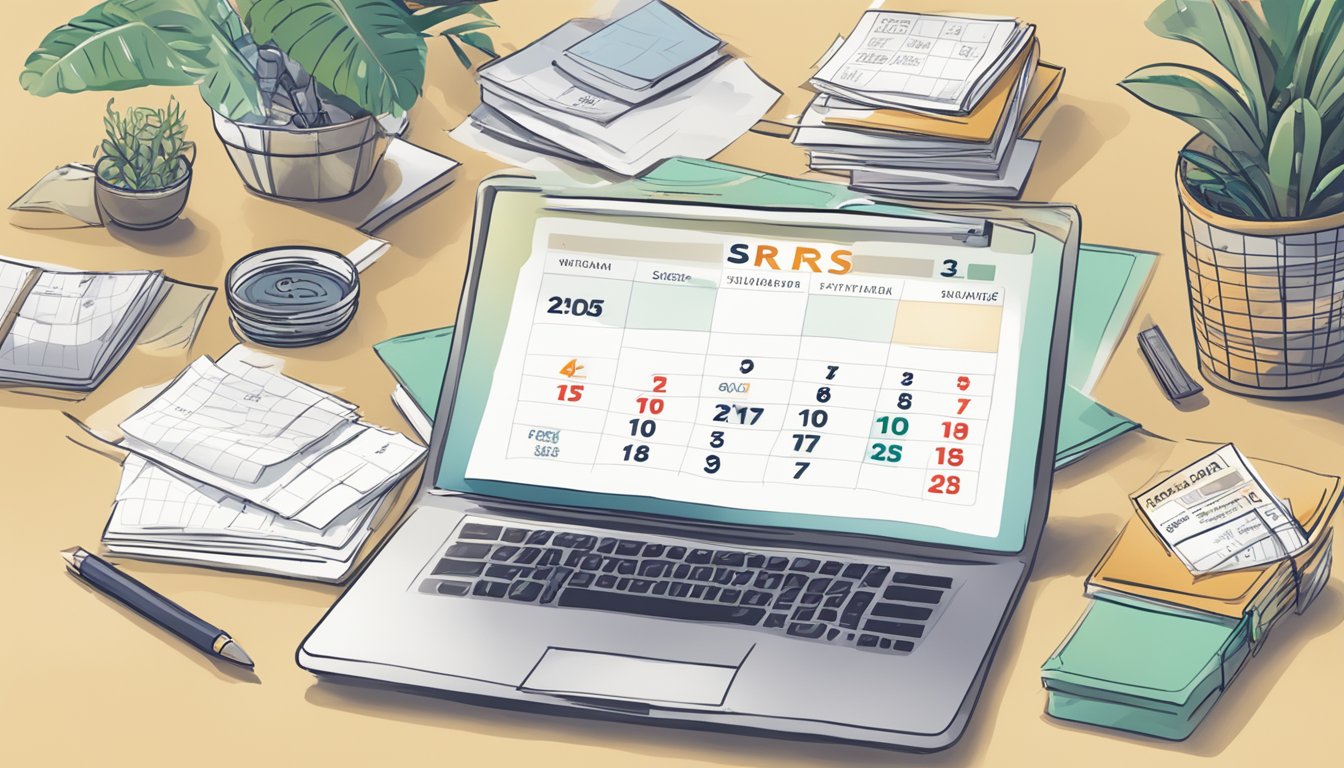Welcome to the world of Supplementary Retirement Scheme (SRS) in Singapore. If you are wondering when you can withdraw your SRS savings, you have come to the right place. In this article, we will explore the withdrawal conditions and penalties of SRS, along with the tax implications of SRS withdrawals.

Before we dive into the details of SRS withdrawals, let’s briefly understand what SRS is and its benefits. SRS is a voluntary scheme that encourages individuals to save for retirement by offering tax benefits. It allows you to save up to $15,300 per year (for Singapore citizens and permanent residents) and $35,700 per year (for foreigners) in a SRS account, which is invested in various financial instruments. The contributions made to SRS are eligible for tax relief, and the investment returns are tax-free until withdrawal.
Now, let’s move on to the main topic of this article – when can you withdraw your SRS savings? The answer is simple – you can withdraw your SRS monies anytime, but there are certain conditions and penalties you need to be aware of. If you withdraw before the current statutory retirement age of 63 years old, there will be a 5% penalty. In addition, all withdrawals made before the retirement age (currently 62) attract a 5% penalty. With that said, let’s explore the withdrawal conditions and penalties of SRS, along with the tax implications of SRS withdrawals.
Key Takeaways
- SRS is a voluntary scheme that encourages individuals to save for retirement by offering tax benefits.
- You can withdraw your SRS monies anytime, but there are certain conditions and penalties you need to be aware of.
- All SRS withdrawals are taxable, and you may apply to withdraw your SRS savings without penalty if you are a foreigner.
Understanding SRS and Its Benefits

What Is the Supplementary Retirement Scheme (SRS)?
The Supplementary Retirement Scheme (SRS) is a voluntary savings scheme that encourages individuals to save for their retirement. It is a government-initiated scheme that complements the Central Provident Fund (CPF) savings. The SRS provides tax relief to encourage Singaporeans and Permanent Residents to save for their retirement and reduce their taxable income.
Advantages of SRS Contributions
There are several advantages of contributing to your SRS account. Firstly, you receive annual dollar-for-dollar tax relief on up to $15,300 for Singaporeans and PRs, and up to $35,700 for foreigners working in Singapore. This is also the maximum you can contribute to your SRS each year.
Secondly, your SRS contributions can be invested in a range of instruments such as stocks, bonds, unit trusts, and insurance products. This provides flexibility and choice to suit your investment goals and risk appetite.
Thirdly, your SRS savings grow tax-free until you withdraw them. This means that you can enjoy tax savings on your investment returns, which can significantly boost your retirement savings.
Finally, your SRS savings can be withdrawn any time after the age of 62, subject to income tax. Early withdrawals are fully subject to tax and attract a 5% penalty. However, you can stagger your withdrawals over a period of up to 10 years to reduce your tax liability.
In summary, the SRS is an excellent retirement savings plan that provides tax relief, investment flexibility, and tax-free growth. By contributing to your SRS account, you can save for your retirement and enjoy tax savings on your investment returns.
Eligibility and Contributions

If you are looking to save for your retirement and reduce your tax bill, then opening an SRS account could be a great option for you. Here are some things you need to know about SRS eligibility and contributions.
Who Can Open an SRS Account?
Anyone can open an SRS account if they are at least 18 years old and not an undischarged bankrupt. This includes Singaporeans, Permanent Residents (PRs), and foreigners. However, if you are a foreigner, you will need to have a valid work pass or employment pass to be eligible.
How to Make SRS Contributions
Making SRS contributions is easy. You can do it through your bank or financial institution. You can choose to make a lump-sum contribution or set up a regular contribution plan. It’s important to note that contributions made within each year’s Year of Assessment (YA) period qualify for deduction.
Contribution Limits and Tax Benefits
There is a cap on how much you can contribute to your SRS account each year. For Singaporeans and PRs, the contribution limit is $15,300 per year, while for foreigners, it is $35,700 per year. However, it’s important to note that the contribution limit is subject to change.
One of the main benefits of contributing to an SRS account is the tax concession. Contributions to SRS are eligible for tax relief, which means that you can reduce your taxable income and pay less in taxes. Investment returns are also tax-free before withdrawal, and only 50% of the withdrawals from SRS are taxable at retirement.
Overall, opening an SRS account and making contributions can help you save for your retirement and reduce your tax bill. Just make sure to stay within the contribution limits and take advantage of the tax benefits available to you.
Withdrawal Conditions and Penalties

If you’re looking to withdraw your SRS savings, it’s essential to understand the conditions and penalties that come with it. Here are some important things you need to know:
When Can Withdrawals Be Made?
Withdrawals from your SRS account can only be made after you have reached the statutory retirement age, which is currently 63 years old. However, you can choose to defer your withdrawals until the age of 70 to maximize your tax savings.
Early Withdrawal Penalties
If you withdraw your SRS savings before the statutory retirement age, you will be subject to a 5% penalty on the withdrawal amount. Additionally, you will be liable to pay income tax on the full withdrawal amount.
Medical Grounds and Other Exceptions
In some cases, you may be able to withdraw your SRS savings early without incurring penalties. For instance, if you’re diagnosed with a terminal illness, you can withdraw your SRS savings without penalty. Additionally, you may be able to withdraw your savings if you face financial hardship or if you’re leaving Singapore permanently.
It’s important to note that even if you’re eligible to withdraw your SRS savings early, you will still be liable to pay income tax on the full withdrawal amount.
To summarize, withdrawing your SRS savings before the statutory retirement age should be avoided unless you have a valid reason. If you’re unsure about whether you should withdraw your savings or not, it’s best to seek advice from a financial advisor.
Tax Implications of SRS Withdrawals

If you’re considering withdrawing from your SRS account, it’s important to understand the tax implications. Here are some things to keep in mind when planning your SRS withdrawals.
Taxation on Withdrawals
Withdrawals from your SRS account are subject to tax. The amount of tax you’ll pay depends on several factors, including your taxable income, the amount you withdraw, and the length of time you’ve had your SRS account.
Generally, withdrawals made before the statutory retirement age are fully taxable and attract a 5% penalty. The current statutory retirement age is 63, but it’s set to increase to 65 by about 2030. However, there are some exceptional circumstances that allow for penalty-free withdrawals before the statutory retirement age.
When you withdraw from your SRS account, the amount you withdraw is added to your taxable income for that year. This means that the amount you withdraw may push you into a higher tax bracket, resulting in a higher tax rate.
Planning for Tax-Efficient Withdrawals
To minimise your tax liability, it’s important to plan your SRS withdrawals carefully. Here are some strategies you can use to make your withdrawals more tax-efficient:
- Spread your withdrawals over several years: By spreading your withdrawals over several years, you can avoid pushing yourself into a higher tax bracket. This can help you minimise your tax liability and maximise your retirement savings.
- Consider your other sources of income: If you have other sources of income, such as rental income or investment income, you’ll need to take these into account when planning your SRS withdrawals. You may want to consult a tax professional to help you determine the best strategy for your situation.
- Take advantage of the concessionary withholding tax rate: If you’re a non-resident, you may be eligible for a concessionary withholding tax rate of 15% on your SRS withdrawals. This can help you minimise your tax liability and maximise your retirement savings.
Remember, withdrawing from your SRS account is a big decision that can have significant tax implications. By understanding the tax implications and planning your withdrawals carefully, you can minimise your tax liability and maximise your retirement savings.
Investment Options Within SRS

If you are considering investing in SRS, there are several investment options available to you. These options include shares, bonds, unit trusts, and Singapore Government Securities. You can also choose to invest in SRS funds, which are specially designed for SRS investments.
Diversifying Your SRS Investments
Diversification is an important aspect of investing. By diversifying your SRS investments, you can spread your risk across different asset classes and reduce the impact of any one investment on your overall portfolio.
You can diversify your SRS investments by investing in a mix of shares, bonds, and unit trusts. This will give you exposure to different sectors and asset classes, which can help to reduce your risk.
Understanding Risks and Returns
When investing in SRS, it is important to understand the risks and returns associated with each investment option. Shares, for example, can provide higher returns but also come with a higher level of risk. Bonds, on the other hand, may provide lower returns but are generally considered less risky.
It is important to work with a wealth planning manager to determine the best investment options for your individual needs and risk tolerance.
Investment returns are also an important consideration. While past performance is not a guarantee of future returns, it can provide an indication of how an investment has performed over time. It is important to consider both short-term and long-term returns when making investment decisions.
Overall, investing in SRS can be a great way to save for your retirement while also reducing your tax liability. By diversifying your investments and working with a wealth planning manager, you can make informed investment decisions that align with your individual needs and goals.
Frequently Asked Questions

What’s the earliest age I can dip into my SRS funds?
You can start withdrawing from your SRS account at the age of 62. However, it’s important to note that any withdrawals made before the age of 62 will be subjected to a 5% penalty fee.
Is there a special strategy for SRS fund withdrawal that I should know about?
Yes, there are strategies that can help you maximize your SRS withdrawals. One such strategy is to stagger your withdrawals over a 10-year period to minimize your tax liability. This means that you can withdraw up to $40,000 per year tax-free.
How does SRS withdrawal work if I’m not a Singaporean citizen?
If you’re not a Singaporean citizen, you can still make withdrawals from your SRS account. However, you’ll be subjected to a withholding tax of 22% on the amount withdrawn. This tax can be reduced if your country of residence has a tax treaty with Singapore.
Can you enlighten me on the conditions for penalty-free SRS withdrawals?
You can withdraw your SRS funds penalty-free under certain conditions. These conditions include death, medical grounds, bankruptcy, and the full withdrawal of the SRS balance by a foreigner provided that the individual is neither a Singapore Citizen nor a Singapore Permanent Resident on the date of withdrawal and for a continuous period of 10 years preceding the date of withdrawal.
What are the steps to withdraw from my SRS account with DBS?
To withdraw from your SRS account with DBS, you’ll need to log in to your DBS iBanking account and follow the instructions provided. Alternatively, you can visit any DBS/POSB branch and request for a withdrawal.
Is it possible to transfer my SRS savings into my CPF account?
No, it’s not possible to transfer your SRS savings into your CPF account. However, you can use your SRS funds to purchase a CPF LIFE plan, which will provide you with a monthly income stream for life.




